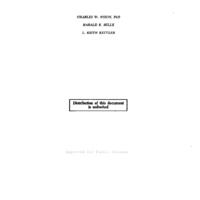-
Title
-
Attenuation Characteristics of Earmuffs at Low Audio and Infrasonic Frequencies
-
Date
-
1967
-
Index Abstract
-
Not Available
-
Photo Quality
-
Not Needed
-
Report Number
-
AMRL TR 67-27
-
Creator
-
Nixon, Charles W.
-
Hille, Harald K.
-
Corporate Author
-
Aerospace Medical Research Laboratories; University of Dayton Research Institute
-
Laboratory
-
Biomedical Laboratory
-
Extent
-
22
-
Identifier
-
AD0655939
-
Access Rights
-
Distribution of this document is unlimited
-
Distribution Classification
-
1
-
Contract
-
Laboratory Research - No Contract
-
DoD Project
-
7231
-
DoD Task
-
723103
-
DTIC Record Exists
-
No
-
Distribution Change Authority Correspondence
-
None
-
Distribution Conflict
-
No
-
Abstract
-
Sound attenuation and transmission loss characteristics of three different earmuffs models were determined from (1) physical measurements of discrete frequency signals in the range from 1 to 500 Hz inside and outside earmuffs being worn by subjects and (2) psychoacoustical or subjective measurements employing the United States of America Institute of Standards 'Real Ear Attenuation at Threshold Method.' Evaluation of the data showed good correlation between the two measurement methods. Greater attenuation was obtained with the subjective method. It was interpreted to be due primarily to the masking effects at threshold of hearing of physiological noise present under the earcups. Findings show that typical present-day earmuffs provide approximately 10 dB of attentuation in the frequency range from 20 to 100 Hz and very little sound protection below 20 Hz. It is recommended that insert earplugs be used for sound protection in intense low audio frequency and infrasonic sound fields. Good earmuffs in combination with insert earplugs should provide more protection than earplugs alone.
-
Report Availability
-
Full text available
-
Date Issued
-
1967-05
-
Provenance
-
RAF Centre of Aviation Medicine
-
Type
-
report
-
Format
-
1 online resource
 AMRLTR67-027.pdf
AMRLTR67-027.pdf